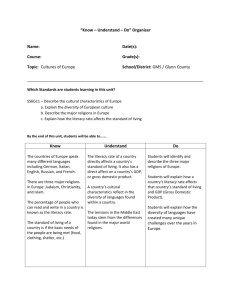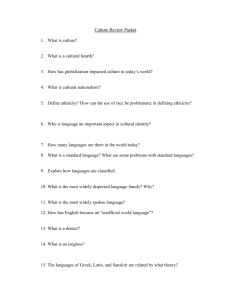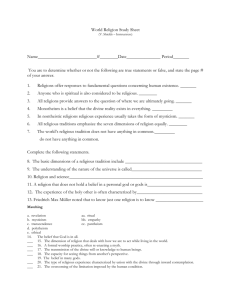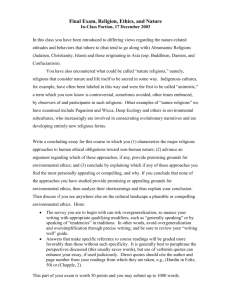study guide religion studies grade 10
advertisement
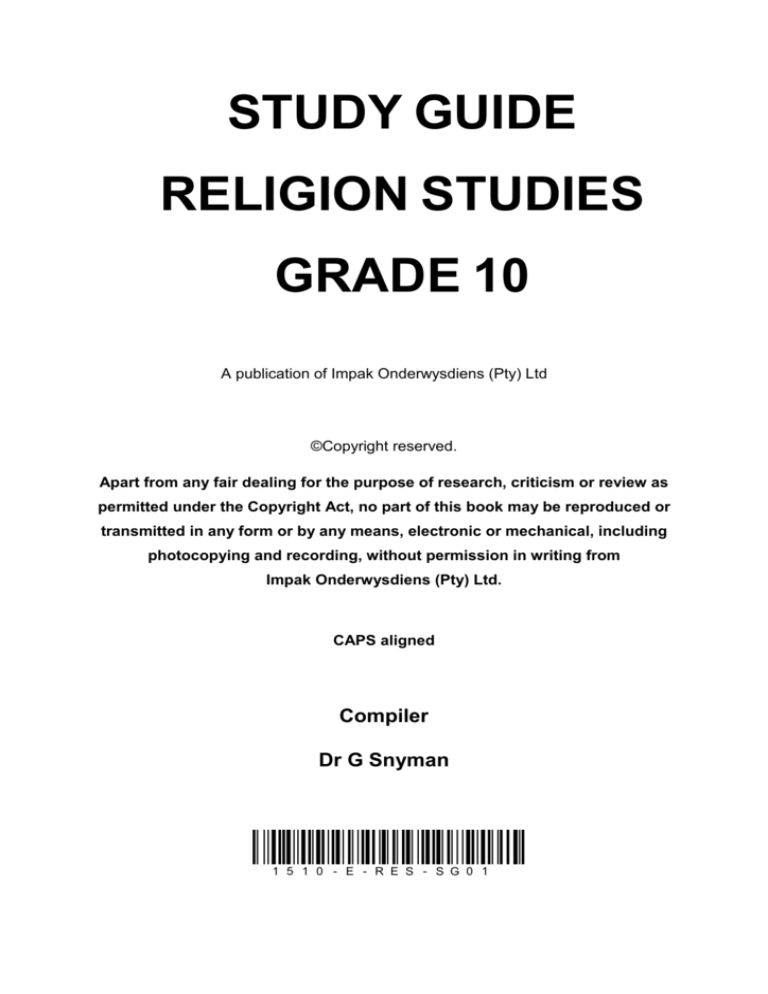
STUDY GUIDE RELIGION STUDIES GRADE 10 A publication of Impak Onderwysdiens (Pty) Ltd ©Copyright reserved. Apart from any fair dealing for the purpose of research, criticism or review as permitted under the Copyright Act, no part of this book may be reproduced or transmitted in any form or by any means, electronic or mechanical, including photocopying and recording, without permission in writing from Impak Onderwysdiens (Pty) Ltd. CAPS aligned Compiler Dr G Snyman Ë1510-E-RES-SG01´ ´ µ Î Study Guide G10 ~ Religion Studies TABLE OF CONTENTS PROLOGUE ........................................................................................................ 4 LESSON ELEMENTS ......................................................................................... 5 RECOMMENDED BOOKS.................................................................................. 7 TERM 1 ............................................................................................................... 9 UNIT 1: Introduction to Religion Studies as subject ...................................... 9 Lesson 1: Welcome and introduction .................................................... 10 ACTIVITY 1: Test questions ................................................. 13 Lesson 2: The development of Religion Studies as a subject ............... 13 ACTIVITY 2: Test questions ................................................. 15 Lesson 3: The objectives of Religion Studies as a subject ................... 15 ACTIVITY 3: Test questions ................................................. 17 Lesson 4: The difference between religious instruction and Religion Studies ............................................................................... 17 ACTIVITY 4: Test questions ................................................. 19 Lesson 5: The preferred method for the study of religion...................... 19 ACTIVITY 5: Test questions ................................................. 21 EXERCISE 1: Open book test .............................................. 21 UNIT 2: Important principles to consider in the study of religions ............. 23 Lesson 6: Objectivity in the study of religion ......................................... 24 ACTIVITY 6: Test questions ................................................. 26 Lesson 7: Subjectivity in the study of religion ....................................... 26 ACTIVITY 7: Test questions ................................................. 27 Lesson 8: Neutrality in the study of religion .......................................... 27 ACTIVITY 8: Test questions ................................................. 29 Lesson 9: Impartiality in Religion Studies ............................................. 29 ACTIVITY 9: Test questions ................................................. 30 Lesson 10: The inner and outer perspective in the study of religions ... 30 ACTIVITY 10: Test questions ............................................... 31 EXERCISE 2: Open book test .............................................. 32 UNIT 3: Different ways to understand the concept of religion .................... 33 Lesson 11: Basic/general facts about religion ...................................... 34 ACTIVITY 11: Test questions ............................................... 35 Lesson 12: Origin of religion as a cultural phenomenon ....................... 36 ACTIVITY 12: Test questions ............................................... 38 Lesson 13: The meaning of the term religion in relation to other concepts like worldview and belief system ........................................ 38 ACTIVITY 13: Test questions ............................................... 39 EXERCISE 3: Open book test .............................................. 40 TERM 2 ............................................................................................................. 41 UNIT 4: The main religions in the world ........................................................ 41 Lesson 14: Origin of the main world religions ....................................... 42 © Impak Onderwysdiens (Pty) Ltd 1 Study Guide G10 ~ Religion Studies ACTIVITY 14: Test questions ............................................... 50 Lesson 15: The size and spread of the main world religions ................ 50 ACTIVITY 15: Test questions ............................................... 52 Lesson 16: The difference between BCE and CE religions .................. 52 ACTIVITY 16: Test questions ............................................... 53 Lesson 17: Most important sacred days of the main world religions ..... 53 ACTIVITY 17: Test questions ............................................... 55 EXERCISE 4: Open book test .............................................. 55 UNIT 5: Geographical grouping of religions ................................................. 56 Lesson 18: Religious grouping in Africa ................................................ 57 ACTIVITY 18: Test questions ............................................... 59 Lesson 19: Religious grouping in Europe ............................................. 59 ACTIVITY 19: Test questions ............................................... 61 Lesson 20: Religious grouping in Asia .................................................. 61 ACTIVITY 20: Test questions ............................................... 62 Lesson 21: Religious grouping in the USA ............................................ 63 ACTIVITY 21: Test questions ............................................... 64 Lesson 22: Religious grouping in Australia ........................................... 64 ACTIVITY 22: Test questions ............................................... 65 Lesson 23: Religious grouping in the Pacific Ocean ............................. 65 ACTIVITY 23: Test questions ............................................... 66 EXERCISE 5: Open book test .............................................. 67 UNIT 6: The different religions in South Africa ............................................. 68 Lesson 24: The religions that are practised in South Africa .................. 69 ACTIVITY 24: Test questions ............................................... 70 Lesson 25: Where and how the different religions originated ............... 70 ACTIVITY 25: Test questions ............................................... 72 Lesson 26: Where the religions of South Africa came from and how they came here .......................................................................... 72 ACTIVITY 26: Test questions ............................................... 74 Lesson 27: The main teachings, books and rituals practised by religions in South Africa.................................................................... 74 ACTIVITY 27: Test questions ............................................... 81 EXERCISE 6: Open book test .............................................. 82 TERM 3 ............................................................................................................. 83 UNIT 7: Interaction between different religious groups ............................... 83 Lesson 28: Religious interaction ........................................................... 84 ACTIVITY 28: Test questions ............................................... 87 EXERCISE 7: Open book test .............................................. 88 EXERCISE 7: OPEN BOOK TEST ................................................................... 88 UNIT 8: The main leadership roles that developed in religions................... 89 Lesson 29: Leadership roles in religions ............................................... 90 EXERCISE 8: Open book test .............................................. 93 © Impak Onderwysdiens (Pty) Ltd 2 Study Guide G10 ~ Religion Studies UNIT 9: The main dimensions common to all religions ............................... 94 Lesson 30: Religious dimensions.......................................................... 95 EXERCISE 9: Open book test .............................................. 97 TERM 4 ............................................................................................................. 99 UNIT 10: Religion and ethics .......................................................................... 99 Lesson 31: Main ethical and moral codes of different religions ........... 100 ACTIVITY 31: Test questions ............................................. 104 Lesson 32: Sources that influence moral decision-making ................. 104 ACTIVITY 32: Test questions ............................................. 106 Lesson 33: Principles according to which religions promote harmony in society .............................................................................. 106 ACTIVITY 33: Test questions ............................................. 108 EXERCISE 10: Open book test .......................................... 108 UNIT 11: Religion and the economy ............................................................ 109 Lesson 34: Religious perspective on the relationship between religion and economy ................................................................... 110 EXERCISE 11: Open book test .......................................... 112 GLOSSARY AND BIBLIOGRAPHY ............................................................... 113 BIBLIOGRAPHY AND REFERENCES ........................................................... 119 © Impak Onderwysdiens (Pty) Ltd 3 Study Guide G10 ~ Religion Studies Term 1 TERM 1 UNIT 1: Introduction to Religion Studies as subject STUDY OBJECTIVES: What the learner should know at the end of the lesson (taken from CAPS). Ø Introduction and welcome Ø The development of Religion Studies as a subject Ø What Religion Studies are Ø Specific objectives in Religion Studies Ø The difference between Religion Studies and teaching religion /religious instruction Ø Methods in studying religions. When you have completed this unit, you should be able to: Ø Describe the origin and development of Religion Studies as a subject Ø Describe what Religion Studies as subject is Ø What the objectives of Religion Studies as a subject are Ø Know and understand the difference between Religion Studies and teaching religion Ø Name the prominent methods in studying religions. INTRODUCTION The purpose of this unit is to introduce you to Religion Studies as an academic subject. IMPORTANT TERMINOLOGY Epoché, phenomenology, religion studies, religious instruction, religious tolerance, history of religion, neutrality, methodology, comparison of religions. © Impak Onderwysdiens (Pty) Ltd 9 Study Guide G10 ~ Religion Studies Term 1 Unit 1 Introduction to religious study as an academic subject consists of Lessons 1-5. Lesson 1 is a welcome and the start of the process to prepare you, the learner, to study religions. Each lesson has any number of religious terms by which you are introduced to a religion and the subject of Religion Studies. Lesson 2 is a basic overview on the development of Religion Studies as an academic subject. Lesson 3 explains the South African Department of Education’s objectives for the study of religions as an academic subject. Lesson 4 explains the difference between religious instruction and religion studies. It is important for learners to grasp the difference because religion studies is not instruction in a/your religion, but the study of the religions that are followed/practiced in our country. Lesson 5 introduces the method that is implemented in this Handbook for the study of religions. The overarching purpose of the unit (1-5) is to introduce you to religion studies as a subject. What is religion studies? Which objectives are envisaged and which method is used in the study of religion as a human phenomenon? Lesson 1: Welcome and introduction DEFINE: Monotheism: a compound noun derived from the Greek words monos ("one/only") and theos ("god"). Monotheism describes a religion that believes in one deity only or venerates only one deity. In the world there are three monotheisms: Yahwism (the Jews’ religion in the worship of Yahweh), Christianity (that worships God) and Islam (Allah). Polytheism: The opposite to monotheism. The word is derived from the Greek words "polus" ("many") and theos ("god"). Polytheism is the religious system where more than one/many/different gods are worshiped. An example of polytheism is Greek or Roman mythology with their many gods and goddesses (collectively called the mytho- © Impak Onderwysdiens (Pty) Ltd 10 Study Guide G10 ~ Religion Studies Term logical pantheon, i.e. all the gods). Pantheism: The compound noun is derived from the Greek words “pan” (“all/everything”) and theos (“god”). Pantheism is the religious form that views everything as divine (and therefore worthy of worship). All that can be seen is viewed as able to serve a divine purpose. Hinduism is an example. Idolatry: When something other than the divine figure in a particular religion is venerated. A very informative example of idolatry was when the people of Israel worshiped a golden image of a calf in the desert when only Yahweh is God. Main religions: defined according to the number of followers worldwide. In South Africa, the religions are Christianity, Islam, Hinduism, Buddhism, Africa Traditional Religions and Judaism. CORE: Welcome to the subject of Religion Studies in Grade 10! We are pleased that you decided to take this subject. From the word go it is important that you know what we are going to do: study the most important religions in the world and which are also in our country. Worldwide, religion is a cultural phenomenon, in other words, wherever you go there will be people that believe in a god/gods/spirits/the supernatural; people who pray, study a sacred book or view life as ordered by the Divine. The concept religion has to do with the worship or veneration of the divine and a sense of religion is the basic acceptance of what cannot be seen. The most common features or elements of religion is a belief/faith in one or more supernatural beings/a “higher power”; prayer as the means of communication of a need; study of one or more sacred writings (for example in the three monotheisms referred to above, respectively the Tanak; the Bible [Old and New Testament] and the Qur’an [or Koran]); a code of conduct; myths and stories; religious rites et cetera. The purpose of this course is to study religion as phenomenon in the cultures and geographical places where it is practiced. We look at what the beliefs are/what they confess, how god/gods/spirits are viewed and how their beliefs influence how they live. In every country on earth you are bound to find more than one religion © Impak Onderwysdiens (Pty) Ltd 11 1



